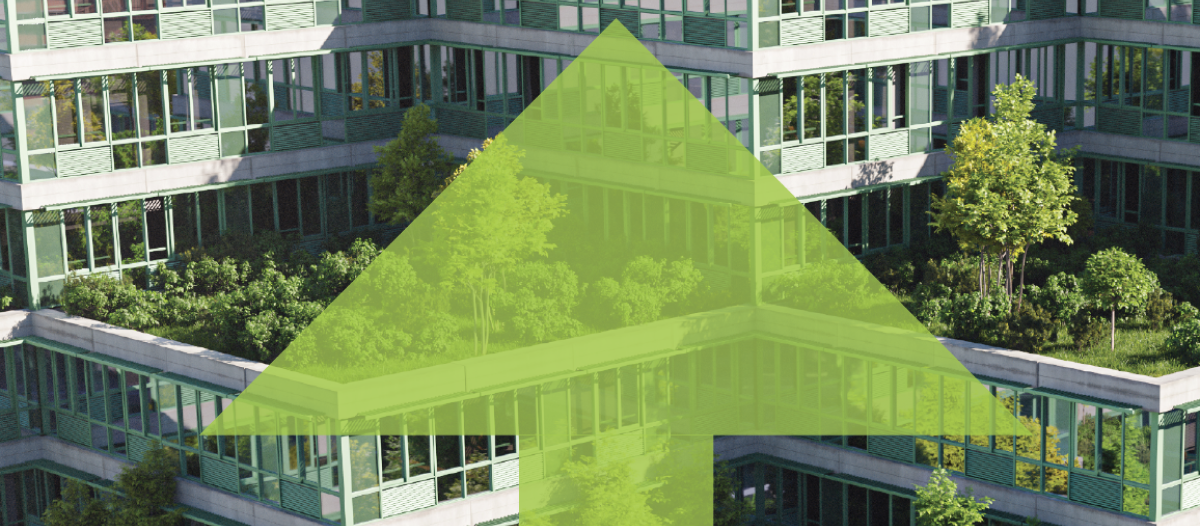Green Business Certifications
FM's Challenges

Climate change is getting worse, and its negative effects are increasing. The built environment is directly responsible for 25-40 percent of emissions globally. The urgency to act on climate change has never been greater, and the built environment sector has responsibility to address the climate emergency and accelerate sector decarbonization as being one of the largest emitters of greenhouse gases (GHGs). Today’s focus on environmental, social and governance (ESG) disclosures are making companies increasingly accountable for their overall environmental impact.
Sustainability is receiving mainstream publicity due to climate change-related disasters around the world. The implementation of sustainability initiatives will be possible through EU Green Deal’s implementations. EU leaders endorse a proposed target to reduce net emissions by at least 55 percent by 2030 compared to 1990 levels. The EU commission proposes to require its member states to renovate at least 3 percent of the total floor area of all public buildings annually, set a benchmark of 49 percent of renewables in buildings by 2030 and require member states to increase the use of renewable energy in heating and cooling by 1.1 percent each year until 2030. Many countries have similar ambitions to align themselves with the 2015 Paris Agreement goals. The challenge is not only climate change.
Business benefits
Over the past 10 years, the costs of water and wastewater services have risen at a rate well above the consumer price index. Facility managers can expect these and other utility costs to continue increasing to offset the costs of replacing aging water supply systems. The business benefits of implementing water-efficiency measures in and around buildings can include reducing operating costs, as well as meeting sustainability goals. Complementing property management activities with ongoing Green FM processes means that up-to-date, sustainability-oriented techniques are in operation, construction and systems are verified as energy efficient and cost savings are obtainable. Green FM service also provides a useful database for comparison and analysis.
To help FMs with green services, relevant global measures have been taken, such as green building standards and regulations, including voluntary green business certification systems (GBCS). Since the 1990s, GBCSs have played an important role in metric-based sustainability decision making in the built environment. BREEAM, LEED and other systems were launched in several countries for new buildings and later for existing buildings.
In 2014, the International Well Building Institute launched WELL, which is focused on the health of building tenants. UK-based Fitwel is designed for single- and multi-tenant buildings and commercial interiors. The systems are designed to work with internationally accepted systems for a sustainable environment, such as LEED and BREEAM. Building owners choosing either of these two systems will gain several advantages, including having more productive and healthier people. Although these two standards have their differences, they focused on implementing strategies for improving the health of the occupants.
Reliable reporting
Building Research Establishment (BRE) in UK launched its BREEAM certification in 1993 for new construction with the intent to promote sustainability in the real estate sector. BRE later launched several different frameworks for existing buildings, communities, refurbishment etc. BREEAM-In-Use (BUI) is a science-based sustainability framework for the verification and certification of operational assets. By establishing a baseline where building owners can set targets and track improvements, higher green rating levels can be achieved. Standards such as BUI (and related green building systems used globally) can guide in making environmental improvements to assets and reduce GHG emissions.
The second widely used system was launched by the US Green Building Council (USGBC) in 1998. The evaluation of existing buildings based on the Building Operations and Maintenance (LEED EBOM) benchmark is based on meeting a series of prerequisites and aspects scored by credits. The certification is achieved by documenting a minimum score through evidence-generated during a period of performance or monitoring by the different intervening agents, such as building managers, maintenance team, contractors, facility manager, suppliers of materials and systems and project information. USGBC released the first draft of LEED v4.1 for LEED O+M. This new rating system will represent a radical shift in how LEED measures the performance of existing buildings. All the typology-based rating systems from V4 have been removed (it used to have separate systems for schools, warehouses, etc.).
Credits add up
Differences among these building types are just dealt with in credit-by-credit requirements. Regional priorities were also removed and the innovation category is made simpler. This rating system is for buildings that are fully operational and occupied for at least one year. It also must include the entire building’s gross floor area in the project. Other new features for V4.1 include a shift to data for documentation by tracking performance in energy, water, waste, transportation, indoor air quality, toxin-free environment and occupant satisfaction. After certification, the building can stay certified with data driven recertification guidance that aligns with certification requirements. The latest version LEED points are based on performance (score) and the first time applies to buildings and interior spaces.
For the LEED v4.1 EBOM rating system, some credits have been removed because their credit intents contribute to the achievement of outcomes that are measured in new credits included in the rating system. The main change of this recertification, LEED-EB v4.1 introduced five performance-based credits: transportation performance (14 points), water performance (15 points), energy performance (33 points), waste performance (8 points) and indoor environmental quality performance (20 points).
Thus, a total of 90 points could be achieved through providing 12 months of data on these performance categories, and this recertification is valid for three years like BUI. The next 10 points can be achieved by applying for additional credits, such as rainwater management (SS category), enhanced refrigerant management (EA category) and integrated pest management (EQ category). LEED-EB v4.1 automatically assigns 10 bonus points to each recertified building (LEED-EB v4.1, 2018). LEED v4.1 has performance-based prerequisites for location and transportation, materials and resources, and indoor environmental quality. The performance prerequisites in water efficiency and energy and atmosphere were kept. A prerequisite energy efficiency best management practices was added that incorporates international alternative compliance path (ACP) allowing projects in Europe to use the energy audit procedure defined in EN 16247-2.2014. There are also minor edits to improve applicability for interiors.
Grid harmonization was added as a new credit title, changing from Demand Response to better reflect options available for teams and credit intent to make energy generation and distribution systems more efficient, increase grid reliability, and reduce GHG emissions. Other credits include purchasing and compliance. There are also reduced thresholds for ongoing consumables, going from 60 percent to 50 percent, while increasing threshold for electronic equipment from 40 percent to 50 percent
The new green cleaning credit is a combination of custodial effectiveness assessment, products, materials and equipment. There are several edits, clarifications and options for this credit. For powered janitorial equipment (Option 3), compliance is now based on percentage of equipment used to clean the project at time of inventory and tracking over the entire year is no longer required and the requirement for a phase-out plan is removed. For cleaning products and materials (Option 4), tracking total annual purchases is no longer required. Compliance may now be demonstrated with a product inventory or from total annual purchases.
Certified transparency
Commercial real estate assets such as office, industrial, retail and multifamily rental buildings adopted BUI and LEED EBOM over the past 29 years. There are many reasons why asset owners and managers get these certifications. Certification brings improved transparency from a known third-party organization. Also, it is a sign of user satisfaction and productivity. The asset owners pay less in their monthly bills so it improves financial performance. With the current updates of both systems, some of the resiliency criteria against extreme climate events are also included. But to comply with full resiliency, resiliency certification systems should be reviewed and used as complimentary (i.e. REDİ and RELİ).
The energy section has the highest percentage in both systems. In BREEAM In-Use Building Performance and Building Management, the environmental weight percentage of the energy is high, and the effect is quite high compared to other evaluation criteria. In building performance, systems such as heating, cooling, ventilation and hot water, the features and efficiency are evaluated. As a result of the BREEAM evaluation, action is taken on the systems that have a negative effect, studies are carried out to increase the efficiency values, and these alternatives are evaluated in any renewal work. After a building is occupied for five years, energy audits are repeated every five years in the BREEAM system. Repeated energy audits show advantages of the improvements suggested by the audit report.
In the building management section, annual consumption data for all types of energy used in building operation are evaluated according to the construction area and type of the building. When there is high consumption, the BREEAM evaluation is adversely affected, and managers start savings to reduce these values and increase the certification level.
In the energy section, the CO2 emission intensity of the fuel type used in the building operation is evaluated and renewable energy alternatives are investigated instead of the fuel types with negative effects. According to the data of the last three years of building energy consumption, the savings rates are evaluated, and strategies are developed for them. Monitoring the monthly energy consumption in the building operation while setting targets is important for the BREEAM evaluation. Sharing all data with building users and management is important for everyone to be involved in achieving goals and compliance. In the BREEAM In-Use energy department, the use of alternative renewable energy sources has a positive impact on evaluation and increases the certification level.
Tenants’ energy use habits have a critical impact on a building’s energy consumption. Tenants were found to be responsible for 14 percent to 65 percent of a building’s total electricity consumption according to a report published on Energy Consumption in Office Buildings: a Comparative Study (2016). Both systems require green leases which will guide tenants on how to use their building efficiently and effectively.
Conclusions
LEED and BREEAM certificates are effective tools for assessing the sustainability of a building during its design, construction and operational stages. Using new and existing building certifications are needed to complete the whole life cycle. Existing building certifications for both BREEAM and LEED systems were recently revised and new versions LEED EBOM V4.1 and BREEAM In Use V6 have been launched. Despite past deficiencies, both systems are now up-to-date related to embodied carbon, LCA and materials. If FMs need to use metrics to measure the performance of their buildings and need ongoing monitoring, both systems provide online tools which make monitoring much easier. Both systems have not yet accumulated the required number of projects to analyze and their success so sharing data and increasing the usage of the systems will help BRE and USGBC type organizations to improve the quality and impact of their systems.

Dr. Duygu Erten works in sustainability of the built environment and has several accreditations as LEED AP, BREEAM AP, BREEAM-In-Use, DGNB In Use and is the chairperson of Climate Change, Energy and Health Department at Istanbul Medipol University. Her research area is green buildings and certification systems. She is a scientific committee member of IFMA and has served on the USGBC Board, LEED Technical Committee and ULI Europe Sustainability Product Council.
References
LEED EBOM, usgbc.org/leed/rating-systems/existing-buildings
BREEAM In Use, breeaminuse.breeam.com/Home/Welcome
breeaminuse.breeam.com/Home/Welcome
Energy Consumption in Office Buildings: a Comparative Study (2016), skanska.pl/4a58d8/siteassets/oferta/biura/raporty-i-standardy/raport-zuycia-energii-w-budynkach-biurowych/energy-consumption-in-office-buildings-report.pdf
sciencedirect.com/topics/earth-and-planetary-sciences/environmental-impact-assessment
usgbc.org/leed/v41
sciencedirect.com/topics/engineering/rainwater
sciencedirect.com/topics/earth-and-planetary-sciences/integrated-pest-management
Sciencedirect.com/science/article/pii/S2405844021021551
sciencedirect.com/topics/economics-econometrics-and-finance/commercial-real-estate
Read more on Sustainability and Leadership & Strategy or related topics Sustainable Facility and Certifications
Explore All FMJ Topics









